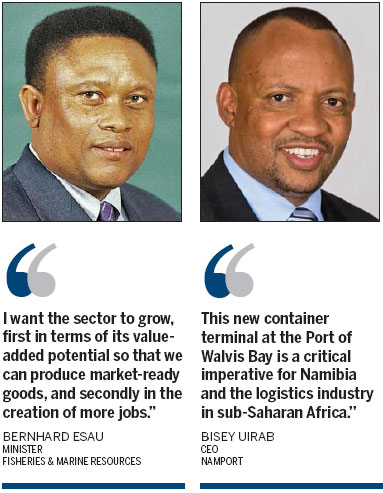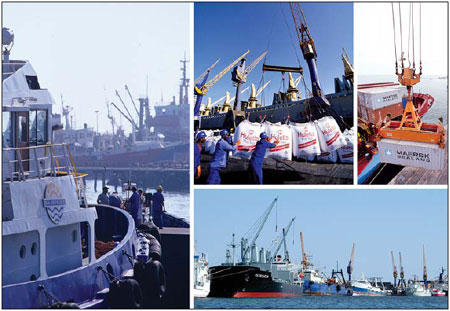Namibia: Aquaculture can lift entire nation
(China Daily) Updated: 2013-09-11 08:12Seeking more investment in rich fishing waters and port logistics
Spanning 1,500 kilometers in total, the final stretch of Namibia's breathtaking coastline was made a protected area in 2010, with Skeleton Coast National Park now covering an area of 16,000 square kilometers.
Off the coast, the country's strategic location on the Benguela current - whose mixture of warm and cold currents provides ideal conditions for fish, seabirds and marine mammals to thrive - means it is home to some of the most abundant supplies of fish in the world.
Official studies have found more than 500 species of fish in Namibia's unpolluted waters. Namibian Minister of Fisheries and Marine Resources Bernhard Esau is keen to see a prominent aquaculture industry develop with China's assistance.
The current focus is on oysters, abalone, seaweed and sea cucumbers in marine waters, and tilapia, catfish and carp in the rivers, but prawns and other species in demand globally could also be cultivated with Chinese help.
Namibia already enjoys a reputation as a high-quality seafood supplier, with high primary productivity and a disease-free status. The minister wants to build on these advantages to reach greater markets.
"The fisheries sector can help us turn our country into a developed one," Minister Esau said. "We should look at how we can best process the fish we catch. China can help us with technology.
"We need vessels that can go into the deep oceans and then look at how we can best exploit the resources in a sustainable fashion.
"Marketing is another area where we can benefit from Chinese expertise. We need to link up our businesspeople with Chinese investors on a joint venture basis."
With China's marine, transport, communications and social infrastructure already in place, its cooperation "could easily propel the industry forward", he said.
Namibia's National Investment Center serves as a clearinghouse that offers a full range of incentives to investors.
A strategic plan has been in place since 2004 to promote the development of the marine aquaculture sector using intensive rearing methods that produce various types of high-value finfish and shellfish, mainly for export.
"I want the sector to grow, first in terms of its value-added potential so that we can produce market-ready goods, and secondly in the creation of more jobs," Esau said.
"The government can then enjoy the revenues provided through the taxes on enterprise and labor, and businesses will get a high return on investment.
"The potential is definitely there for Namibia and China to engage in promising aquaculture and business relations, one where Namibia exports aquaculture products to the Chinese market and China in turn exports technology."
The minister also believes intervention in aquaculture will increase fish production for the growing global population.
"I am encouraged by the fact that the current up-to-date fish-processing infrastructure in Namibia can aid in the processing of aquaculture products as well. This opportunity and strength has to be utilized," he concluded.
As a member of the Southern African Development Community, Namibia enjoys duty-free access for its goods and products to more than a dozen regional countries and more than 250 million consumers.
Gateway to global trade
Strategically located midway along Namibia's extensive and resource-rich coast, the Port of Walvis Bay is a natural gateway for international trade and provides fast and direct access to principal shipping routes between Southern Africa, Europe and the Americas.
The Port of Lderitz caters to local and international shipments to and from southern Namibia and provides excellent access to markets in the northern cape of South Africa.
Both ports are managed by the National Port Authority, known as NamPort.
Its key responsibilities include developing and preparing the ports for future demand, facilitating the country's economic growth by enabling cross-border trade and contributing to the competitiveness of the SADC region's trade through efficient, reliable and cost-effective port services.
The successful and forward-thinking organization has been led by CEO Bisey Uirab since 2009, with the talented businessman focused on making NamPort one of the country's most prized institutions and Namibia a leading logistics hub and destination for cruise ships. The company has an ambitious plan to create at least 5,000 new jobs over the next few years.
The Port of Walvis Bay handles up to 3,000 vessel arrivals and departures each year and around 5 million tons of cargo.
Earlier this year, NamPort closed a $300 million tender for the construction of a major extension to the port, with three offers received from Chinese companies.
"This new container terminal at the Port of Walvis Bay is a critical imperative for Namibia and the logistics industry in sub-Saharan Africa," said Uirab.
"Before re-integration, the Walvis Bay was positioned as a feeder port, but through the new container terminal we will realize NamPort's vision of the best performing world-class port in Africa and also a hub port.
"Namibia's fourth National Development Plan envisions the port as the preferred African west coast port and logistics corridor for southern and central African logistics operations."
The port's planned expansion "will allow us to increase our container throughput as well as competitiveness in the southern African region by increasing our capacity three-fold and accommodating deeper draft vessels", he said.
"Once the new container terminal has been commissioned, it's envisaged that the current terminal area can be made available to handle other commodities as well as accommodate ship repair activities and oil rig repairs. "However, to accommodate longer term growth, we are considering various additional port expansion scenarios."
|
The fisheries and marine sector is one of the most important in Namibia's economy. The country is seeking foreign investment and expertise to expand ports, fleets and processing facilities. Photos Provided to China Daily |

(China Daily 09/11/2013 page7)




